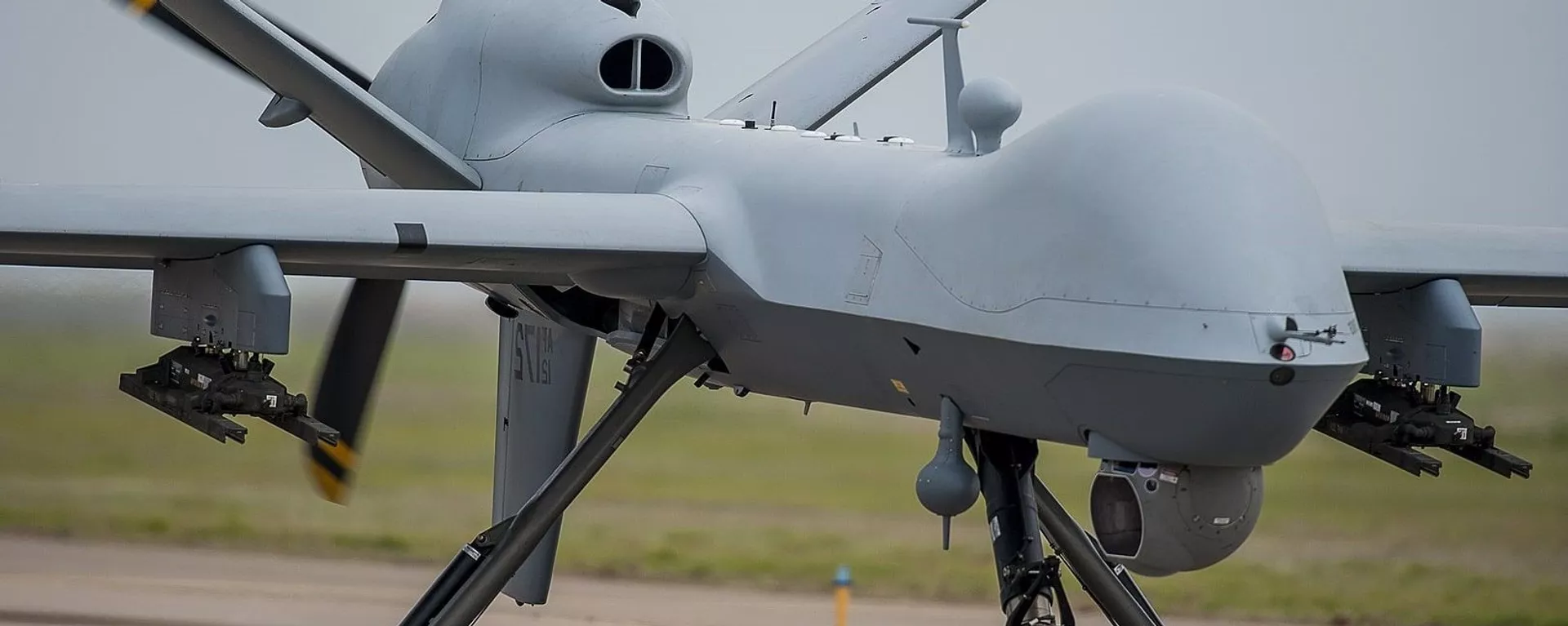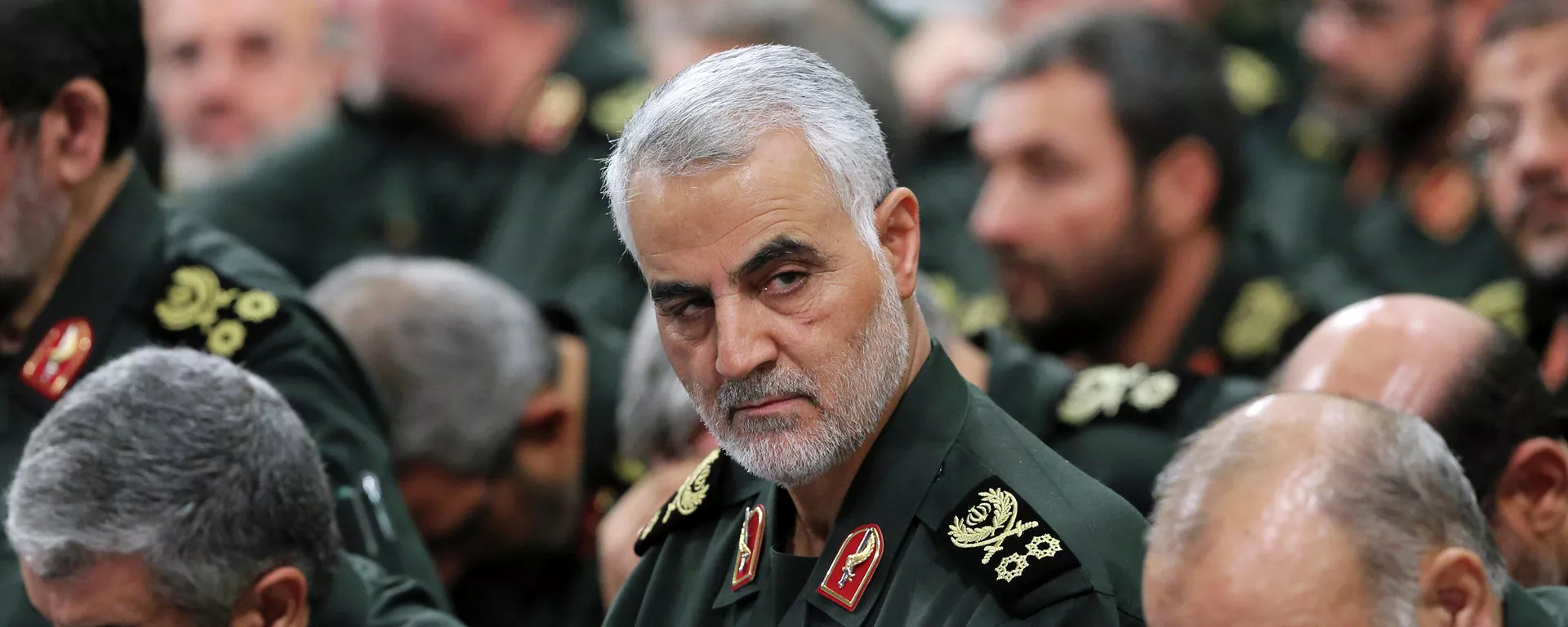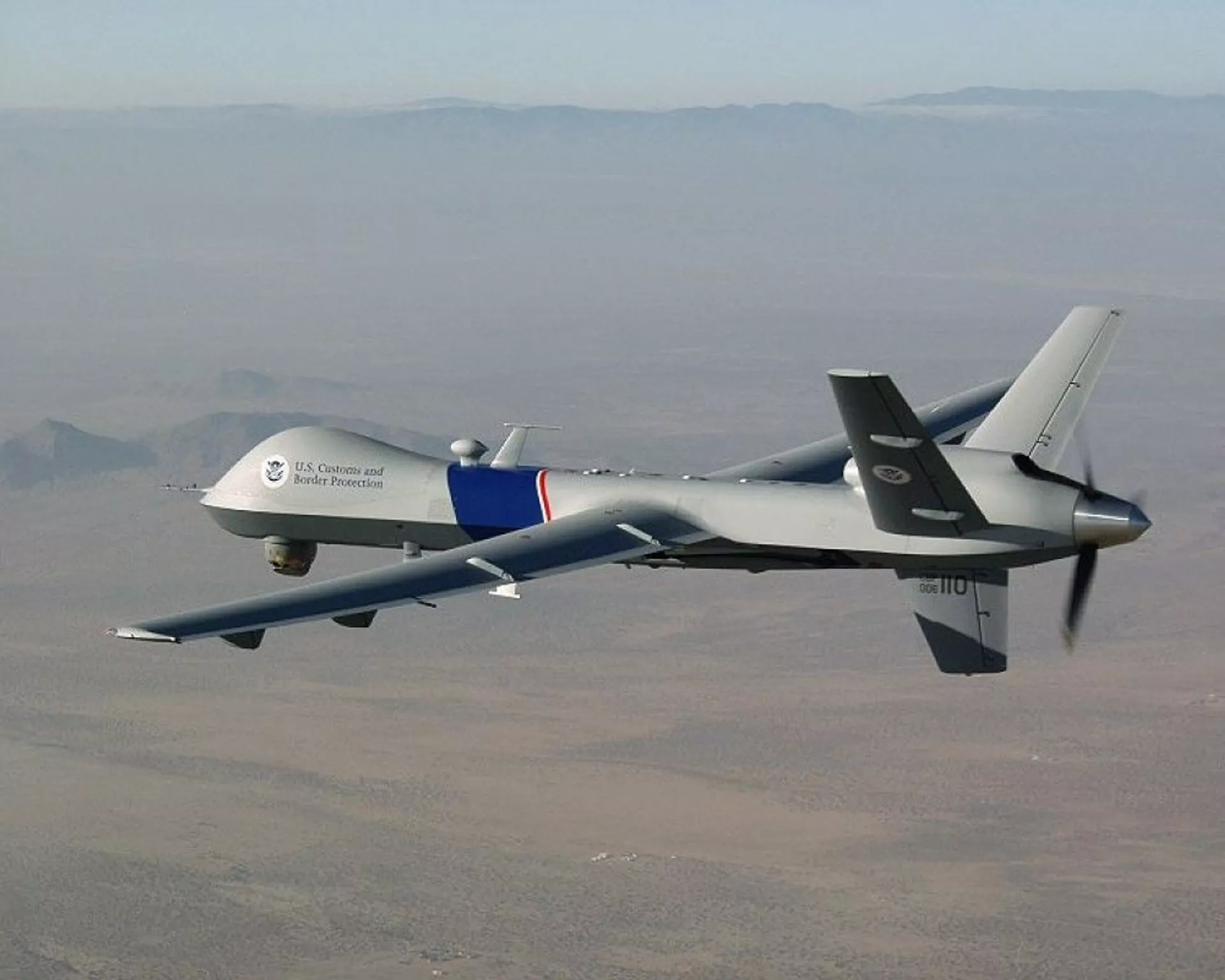https://sputnikglobe.com/20230314/what-is-the-us-air-forces-mq-9-reaper-drone-at-center-of-the-black-sea-incident-1108400245.html
What is the US Air Force’s MQ-9 Reaper Drone at Center of Black Sea Incident?
What is the US Air Force’s MQ-9 Reaper Drone at Center of Black Sea Incident?
Sputnik International
As the US launched its Global War on Terror in the early 21st century, it needed a new high-tech weapon to minimize the risk of US casualties that could sap domestic morale for the operations. Enter: the MQ-9 Reaper, a hunter-killer drone flown from afar and sporting numerous weapons to rain death from above.
2023-03-14T21:43+0000
2023-03-14T21:43+0000
2023-07-16T05:54+0000
sputnik explains
mq-9 reaper
su-27
general atomics
drone
black sea drone incident
uav
https://cdn1.img.sputnikglobe.com/img/107265/88/1072658817_0:130:1280:850_1920x0_80_0_0_3e6d259602215b595fd7e1ee369cd18a.jpg.webp
Western media reports on Tuesday claimed a Russian Su-27 interceptor aircraft over the Black Sea collided with a US Air Force MQ-9 Reaper unmanned aerial vehicle (UAV), sending the drone into a tailspin and a crash. However, Moscow has since detailed that the drone crashed because of its own extreme maneuvers and no physical interaction ever happened.Origins of the ReaperAlso called the Predator-B, the Reaper is a major improvement of the earlier MQ-1 Predator drone, performing virtually all of its roles better. Both are built by General Atomics.The first Reaper flew in February 2001, the same month a Predator was first fitted with a Hellfire anti-tank missile. The new UAV was envisioned primarily as a hunter-killer and its design reflects that: it has a more powerful engine, bigger wings, faster speed, higher flying altitude, and a much greater lifting capacity.Its engine went from 115 horsepower to 900 horsepower; its speed went from 135 miles per hour to 276 miles per hour; its wingspan went from 55 feet to 66 feet; its length went from 27 feet to 36 feet; and its lifting capacity increased from just 450 pounds and two hardpoints to 3,850 pounds with seven hardpoints. Its service ceiling also doubled, from 25,000 feet to 50,000 feet. However, its endurance declined from 24 hours of loitering time by the Predator to just 14 hours for the Reaper if it’s fully loaded with munitions. Without weapons, a Reaper can loiter for 42 hours.Reaper VariantsA further “extended range” upgrade to the Reaper allows it to loiter for between 34 and 40 hours carrying a full load.The US Customs and Border Protection (CBP), a federal law enforcement agency, also has two special Guardian variants made to meet American air standards; however, most military drones cannot be flown in US airspace, save for thin strips of land along the US borders with Mexico and Canada.A later modification of the MQ-1 Predator, the MQ-1C Gray Eagle, was also used as a hunter-killer, although it was a modification of the Predator airframe, not a completely new vehicle like the Reaper, so its capabilities remained inferior to the Reaper.What Equipment Can the Reaper Carry?Because it was intended to be essentially a remotely piloted strike aircraft, the Reaper has substantial offensive capabilities.In addition, the Reaper sports an AN/APY-8 Lynx radar, a Ku-Band high resolution, all-weather synthetic aperture radar and ground motion target indicator (GMTI) system. It has a maximum resolution of 4 inches and a maximum instrumented range of 87 kilometers.Who Flies the Reaper?It was initially made for the US Air Force, but has since been sold in small numbers to the United Kingdom, Spain, Italy, the Netherlands, India, Japan, and France.Aside from those users, sales of US drones on the international market has largely been blocked by laws designed to prevent the proliferation of ballistic missile technology.Where Has the Reaper Performed Missions?The MQ-9 is most notorious for its air missions over Iraq, Afghanistan, Yemen, Syria, and Pakistan, which began in 2007, launching airstrikes against the Taliban*, Al-Qaeda**, and other militia groups fighting the US and its allies.Reapers have been used extensively by US Africa Command (AFRICOM) for missions ranging from anti-piracy patrols in the Seychelles to airstrikes against Al-Shabaab in Somalia and operations against Daesh-affiliated* militias in Mali, Niger, and Libya in conjunction with French forces.Many Reapers have been shot down across all theaters by surface-based anti-air systems ranging from Soviet-era SA-6 KUB systems to modern Russian-made Pantsir vehicles. At least one Reaper was shot down by a USAF F-15 Eagle after connection was lost with the UAV and it veered toward the Afghan-Tajik border.How Many Reapers Does the US Have?The US has a fleet of at least 300 Reaper drones of all varieties, with other nations having no more than a handful each.How Much Does a Reaper Cost?The drone’s cost has steadily increased since it was introduced. The first Reapers in 2008 cost $14 million each, but by 2020, their price had ballooned to $32 million each, making them more expensive than an AH-64E Apache attack helicopter and even more expensive than some older varieties of F-16 Falcon fighter jets.*The Taliban: a group under UN sanctions over terrorist activities.**Al-Qaeda, Daesh (also known as ISIS/ISIL/IS), are terrorist organizations outlawed in Russia and many other states.
https://sputnikglobe.com/20230314/russian-mod-on-us-drone-incident-uav-was-flying-with-transponders-turned-off-towards-russian-border-1108397416.html
https://sputnikglobe.com/20230201/deal-of-the-century-us-firm-offers-ukraine-two-combat-drones-for-one-dollar-1106875280.html
https://sputnikglobe.com/20230103/iran-issues-court-notices-to-73-people-involved-in-assassination-of-soleimani-1106013865.html
Sputnik International
feedback@sputniknews.com
+74956456601
MIA „Rossiya Segodnya“
2023
News
en_EN
Sputnik International
feedback@sputniknews.com
+74956456601
MIA „Rossiya Segodnya“
Sputnik International
feedback@sputniknews.com
+74956456601
MIA „Rossiya Segodnya“
black sea, mq-9 reaper drone, us air force,
black sea, mq-9 reaper drone, us air force,
What is the US Air Force’s MQ-9 Reaper Drone at Center of Black Sea Incident?
21:43 GMT 14.03.2023 (Updated: 05:54 GMT 16.07.2023) As the US launched its Global War on Terror in the early 21st century, it needed a new high-tech weapon to minimize the risk of US casualties that could sap domestic morale for the operations. Enter: the MQ-9 Reaper, a hunter-killer drone flown from afar and sporting numerous weapons to rain death from above.
Western media reports on Tuesday claimed a Russian Su-27 interceptor aircraft over the Black Sea collided with a US Air Force MQ-9 Reaper unmanned aerial vehicle (UAV), sending the drone into a tailspin and a crash. However, Moscow has since detailed that
the drone crashed because of its own extreme maneuvers and no physical interaction ever happened.Also called the Predator-B, the Reaper is a major improvement of the earlier MQ-1 Predator drone, performing virtually all of its roles better. Both are built by General Atomics.
The Predator was introduced in 1995 as a surveillance aid and was later modified in 2001 to carry a small number of rockets or bombs, although its small size severely limited that ability. By the time of the onset of the War on Terror, in which the US relied heavily on UAVs to carry out clandestine strikes in remote areas around the globe, the need for an upgraded Predator became painfully relevant.
The first Reaper flew in February 2001, the same month a Predator was first fitted with a Hellfire anti-tank missile. The new UAV was envisioned primarily as a hunter-killer and its design reflects that: it has a more powerful engine, bigger wings, faster speed, higher flying altitude, and a much greater lifting capacity.
Its engine went from 115 horsepower to 900 horsepower; its speed went from 135 miles per hour to 276 miles per hour; its wingspan went from 55 feet to 66 feet; its length went from 27 feet to 36 feet; and its lifting capacity increased from just 450 pounds and two hardpoints to 3,850 pounds with seven hardpoints. Its service ceiling also doubled, from 25,000 feet to 50,000 feet.
However, its endurance declined from 24 hours of loitering time by the Predator to just 14 hours for the Reaper if it’s fully loaded with munitions. Without weapons, a Reaper can loiter for 42 hours.
A further “extended range” upgrade to the Reaper allows it to loiter for between 34 and 40 hours carrying a full load.
Further variants of the Reaper include the SeaGuardian, which has a greatly improved fuel capacity and radar system, a reinforced airframe for aircraft carrier landings, and a special adaptor for carrying and dropping sonobuoys, which are used to detect submarines and other underwater objects. The SkyGuardian was a modified version made to fit standards for use in and by European nations, with the benefit of a massive 79-foot wingspan.
The US Customs and Border Protection (CBP), a federal law enforcement agency, also has two
special Guardian variants made to meet American air standards; however, most military drones cannot be flown in US airspace, save for thin strips of land along the US borders with Mexico and Canada.
The US space agency NASA has a variant called Altair, which is modified for greater range and loitering time in order to perform science missions and help keep track of its space assets as they fall back to Earth, especially the Orion space capsule.
A later modification of the MQ-1 Predator, the MQ-1C Gray Eagle, was also used as a hunter-killer, although it was a modification of the Predator airframe, not a completely new vehicle like the Reaper, so its capabilities remained inferior to the Reaper.
What Equipment Can the Reaper Carry?
Because it was intended to be essentially a remotely piloted strike aircraft, the Reaper has substantial offensive capabilities.
With seven hardpoints on which to mount weapons, the Reaper can carry AGM-114 Hellfire missiles; GBU-12 Paveway II laser-guided bombs; GBU-38 Joint Direct Attack Munitions (JDAMs), the Brimstone ground strike missile, a modified version of the Stinger shoulder-fired anti-air missile that can be fired from the air, and the AIM-9X Sidewinder anti-air missile.
In addition, the Reaper sports an AN/APY-8 Lynx radar, a Ku-Band high resolution, all-weather synthetic aperture radar and ground motion target indicator (GMTI) system. It has a maximum resolution of 4 inches and a maximum instrumented range of 87 kilometers.

1 February 2023, 09:16 GMT
It was initially made for the US Air Force, but has since been sold in small numbers to the United Kingdom, Spain, Italy, the Netherlands, India, Japan, and France.
Aside from those users, sales of US drones on the international market has largely been
blocked by laws designed to prevent the proliferation of ballistic missile technology.
Where Has the Reaper Performed Missions?
The MQ-9 is most notorious for its air missions over Iraq, Afghanistan, Yemen, Syria, and Pakistan, which began in 2007, launching airstrikes against the Taliban*, Al-Qaeda**, and other militia groups fighting the US and its allies.
The most provocative use of a Reaper in an airstrike was the January 3, 2020, attack that killed Iranian Maj. Gen. Qasem Soleimani and Iraqi paramilitary leader Abu Mahdi al-Muhandis outside Baghdad International Airport in Iraq. The Reaper deployed a unique spinning-blade missile without an explosive payload.
Reapers have been used extensively by US Africa Command (AFRICOM) for missions ranging from anti-piracy patrols in the Seychelles to airstrikes against Al-Shabaab in Somalia and operations against Daesh-affiliated* militias in
Mali, Niger, and Libya in conjunction with French forces.

3 January 2023, 14:12 GMT
They have also been used in air patrols along the Russian border, flying from bases in Romania and Poland. One incident on March 14, 2023, reportedly involved one such Reaper drone, which the US claimed crashed after a Russian Su-27 interceptor harassed and collided with it over the Black Sea; however the Russian government denies any physical contact took place and said the drone crashed due to its own extreme maneuvering.
Many Reapers have been shot down across all theaters by surface-based anti-air systems ranging from Soviet-era SA-6 KUB systems to modern Russian-made Pantsir vehicles. At least one Reaper was shot down by a USAF F-15 Eagle after connection was lost with the UAV and it veered toward the Afghan-Tajik border.
How Many Reapers Does the US Have?
The US has a fleet of at least 300 Reaper drones of all varieties, with other nations having no more than a handful each.
How Much Does a Reaper Cost?
The drone’s cost has steadily increased since it was introduced. The first Reapers in 2008 cost $14 million each, but by 2020,
their price had ballooned to $32 million each, making them more expensive than an AH-64E Apache attack helicopter and even more expensive than some older varieties of
F-16 Falcon fighter jets.
*The Taliban: a group under UN sanctions over terrorist activities.
**Al-Qaeda, Daesh (also known as ISIS/ISIL/IS), are terrorist organizations outlawed in Russia and many other states.







